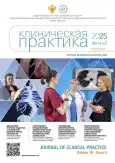Optimizing the fluorescent visualization with Indocyanine green during laparoscopic cholecystectomy
- Authors: Kosachenko M.V.1, Leonovich A.M.1, Klimov A.E.1, Burlakova A.V.1
-
Affiliations:
- Peoples’ Friendship University of Russia
- Issue: Vol 16, No 2 (2025)
- Pages: 34-40
- Section: Original Study Articles
- URL: https://bakhtiniada.ru/clinpractice/article/view/312007
- DOI: https://doi.org/10.17816/clinpract685076
- EDN: https://elibrary.ru/GHHXHU
- ID: 312007
Cite item
Abstract
BACKGROUND: The prevention of damaging the bile ducts during surgical interventions in patients with calculous cholecystitis remains a topical problem in modern abdominal surgery. The incidence of damaging the bile ducts reaches 0.4–2%, while in cases of complicated forms — up to 5.2%. AIM: determining the optimal dosage and timing of administering the Indocyanine green (ICG) for increasing the efficiency of fluorescent cholangiography during the course of laparoscopic cholecystectomy in cases of calculous cholecystitis. The top-priority task of the research is minimizing the risks of injuring the bile ducts by means of clear intraoperative visualization of the extrahepatic bile ducts. METHODS: Prospective non-randomized research was conducted within the premises of the University Clinical Center named after V.V. Vinogradov (affiliated branch) of the RUDN University during the period from March 2024 until April 2025. The research included 276 patients undergoing the laparoscopic cholecystectomy with using the ICG-cholangiography. The dosages of Indocyanine green used (1.25 mg; 2.5 mg; 5 mg; 10 mg) were administered in various time periods before starting the surgery (from 40 minutes up to 6 hours), as well as intraoperatively. The evaluation included the degree of fluorescence, the time from the moment of administering the Indocyanine green until the optimal fluorescence of the bile ducts and of the liver required for the safe conduction of laparoscopic cholecystectomy, as well as the possibility to correct the hyper- and hypofluorescence by changing the equipment settings. RESULTS: Optimal visualization of the extrahepatic bile ducts was observed at a dosage of 5 mg of ICG 3–5 hours after the administration, for the 2.5 mg dosage — 2–3 hours, while for the 1.25 mg dosage, the time was 40–120 minutes. Intraoperative administration of 1.25 mg provided a rapid visualization, but caused hyperfluorescence, complicating the determination of the topography of bile ducts, which was corrected by equipment settings. CONCLUSION: Fluorescent cholangiography with using the Indocyanine green is a safe and effective method of visualizing the extrahepatic bile ducts during laparoscopic cholecystectomy. The most optimal dosages of Indocyanine green are the following: 1.25 mg — 40–120 minutes, 2.5 mg — 2–3 hours and 5 mg — 3–5 hours before the intervention. The 1.25 mg dosage can be administered intraoperatively with further correction of equipment settings at the menu of the video-system (by lowering the enhancement and the intensity parameters) for decreasing the hyperfluorescence effect.
Full Text
##article.viewOnOriginalSite##About the authors
Mikhail V. Kosachenko
Peoples’ Friendship University of Russia
Author for correspondence.
Email: kosach13@mail.ru
ORCID iD: 0000-0002-9735-6219
SPIN-code: 6638-4286
MD, PhD
Russian Federation, 6 Miklukho-Maklaya st, Moscow, 117198Alexander M. Leonovich
Peoples’ Friendship University of Russia
Email: leon_vgmu@mail.ru
ORCID iD: 0009-0007-1701-3042
Russian Federation, 6 Miklukho-Maklaya st, Moscow, 117198
Aleksei E. Klimov
Peoples’ Friendship University of Russia
Email: klimov.pfu@mail.ru
ORCID iD: 0000-0002-1397-9540
SPIN-code: 8816-8365
MD, PhD, Professor
Russian Federation, 6 Miklukho-Maklaya st, Moscow, 117198Anna V. Burlakova
Peoples’ Friendship University of Russia
Email: burlakova.09@list.ru
ORCID iD: 0000-0002-1248-7579
SPIN-code: 5285-6367
Russian Federation, 6 Miklukho-Maklaya st, Moscow, 117198
References
- Alexander HC, Bartlett AS, Wells CI, et al. Reporting of complications after laparoscopic cholecystectomy: A systematic review. HPB (Oxford). 2018;20(9):786–794. doi: 10.1016/j.hpb.2018.03.004
- Гальперин Э.И., Чевокин А.Ю. «Свежие» повреждения желчных протоков // Хирургия. Журнал им. Н.И. Пирогова. 2010. № 10. С. 4–10. [Galperin EI, Chevokin AIu. Intraoperative injuries of bile ducts. N.I. Pirogov Journal of Surgery. 2010;(10):4–10]. EDN: NQZLLX
- Mallet-Guy P, Kesterns PL. Syndrome post-cholecystectomie. Paris: Masson et Cie; 1970.
- Vincenzi P, Mocchegiani F, Nicolini D, et al. Bile duct injuries after cholecystectomy: An individual patient data systematic review. J Clin Med. 2024;13(16):4837. doi: 10.3390/jcm13164837
- De Angelis N, Catena F, Memeo R, et al. 2020 WSES guidelines for the detection and management of bile duct injury during cholecystectomy. World J Emerg Surg. 2021;16(1):30. doi: 10.1186/s13017-021-00369-w
- Strasberg SM, Hertl M, Soper NJ. An analysis of the problem of biliary injury during laparoscopic cholecystectomy. J Am Coll Surg. 1995;180(1):101–125.
- Ostapenko A, Kleiner D. Challenging orthodoxy: Beyond the critical view of safety. J Gastrointest Surg. 2023;27(1):89–92. doi: 10.1007/s11605-022-05500-z
- Yang S, Hu S, Gu X, Zhang X. Analysis of risk factors for bile duct injury in laparoscopic cholecystectomy in China: A systematic review and meta-analysis. Medicine (Baltimore). 2022;101(37):e30365. doi: 10.1097/MD.0000000000030365
- Kono Y, Ishizawa T, Tani K, et al. Techniques of fluorescence cholangiography during laparoscopic cholecystectomy for better delineation of the bile duct anatomy. Medicine (Baltimore). 2015;94(25):e1005. doi: 10.1097/MD.0000000000001005
- Manasseh M, Davis H, Bowling K. Evaluating the role of indocyanine green fluorescence imaging in enhancing safety and efficacy during laparoscopic cholecystectomy: A systematic review. Cureus. 2024;16(11):e73388. doi: 10.7759/cureus.73388
- Serban D, Badiu DC, Davitoiu D, et al. Systematic review of the role of indocyanine green near-infrared fluorescence in safe laparoscopic cholecystectomy (Review). Exp Ther Med. 2022;23(2):187. doi: 10.3892/etm.2021.11110
- Papayan G, Akopov A. Potential of indocyanine green near-infrared fluorescence imaging in experimental and clinical practice. Photodiagnosis Photodyn Ther. 2018;24:292–299. doi: 10.1016/j.pdpdt.2018.10.011
- Pardo Aranda F, Gené Škrabec C, López-Sánchez J, et al. Indocyanine green (ICG) fluorescent cholangiography in laparoscopic cholecystectomy: Simplifying time and dose. Dig Liver Dis. 2023;55(2):249–253. doi: 10.1016/j.dld.2022.10.023
- Wang X, Teh CS, Ishizawa T, et al. Consensus guidelines for the use of fluorescence imaging in hepatobiliary surgery. Ann Surg. 2021;274(1):97–106. doi: 10.1097/SLA.0000000000004718.
Supplementary files








